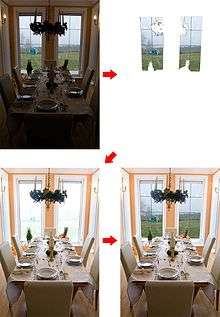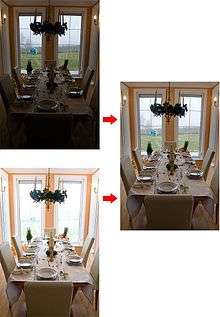Exposure fusion
In image processing, computer graphics, and photography, exposure fusion is a technique for blending multiple exposures of the same scene (bracketing) into a single image. As in high dynamic range imaging (HDRI or just HDR), the goal is to capture a scene with a higher dynamic range than the camera is capable of capturing with a single exposure. [1][2]


Technique
By using different exposure parameters on the same scene, a wider dynamic range can be represented and later merged into an image with better dynamic range. After correcting for small shifts that may inadvently happen with hand-held devices, the full-image can be fused in two ways:[3]
- A higher dynamic range raw image can be reassembled and tone-mapped like usual HDR images,[4][5] or more commonly:
- A blended image can be directly produced without reconstructing a higher bit-depth.[6]
The former method assumes a linear response from the camera, which may be provided by DNG or other raw formats. Some variants can take developed images, but the process of reconstructing the intensities is complicated and noisy, compromising the effective dynamic range.[5]
The latter method [Mertens-Kautz-Van Reeth (MKVr)] only cares about aligning features and taking the best parts, automatically (by contrast, saturation, and well-exposedness) or manually, so it is immune to this drawback. However, it cannot be considered a true HDR technique because no HDR image is ever created. The image does look better on displays, but the resulting bit depth of the image is equal to the input depth, unlike on a true HDR image where a greater bit depth allows storing more detailed intensity changes.[1] Flexibility being its strength, this method can be extended to perform focus stacking by using contrast as the sole criteria.[7]
In photomicrography
In photomicrography, the exposure fusion is often the only way how to acquire properly exposed images from stereomicroscopes. One of the software solutions designed for photomicrography is the HDR module for QuickPHOTO microscopy software. This module can be also combined with Deep Focus focus stacking module to solve another problem, which is shallow depth of field of stereomicroscopes.
Software
Notes
References
- Evans, Mark (2009), Exposure Fusion: What is it? How does it Compare to HDR? How Do I Do It?, retrieved 2011-01-21
- McNeal, Kevin (2010), Exposure Fusion – Best Way To Blend Images, retrieved 2011-01-21
- Ward, Greg (6 April 2012). "Fast, Robust Image Registration for Compositing High Dynamic Range Photographs from Hand-Held Exposures" (PDF). Journal of Graphics Tools. 8 (2): 17–30. doi:10.1080/10867651.2003.10487583.
- Luijk, Guillermo. "Zero Noise Virtual RAW". Zero Noise Photography. Retrieved 11 May 2019.
- "What is HDRMerge?". HDRMerge Documentation. Retrieved 11 May 2019.
HDRMerge merges raw images directly, without development. In fact, it can safely assume a linear response function of the camera.
- Mertens, Tom; Kautz, Jan; Van Reeth, Frank (2007). "Exposure Fusion". Pacific Graphics. Retrieved 2011-01-21.
- Mihal, Andrew; Spiel, Christoph. "Combining Multiple Images with Enfuse 4.2". enblend.sourceforge.net. Retrieved 11 May 2019.
See also
- Focus stacking, the process of merging images with different focus to create a larger depth-of-field